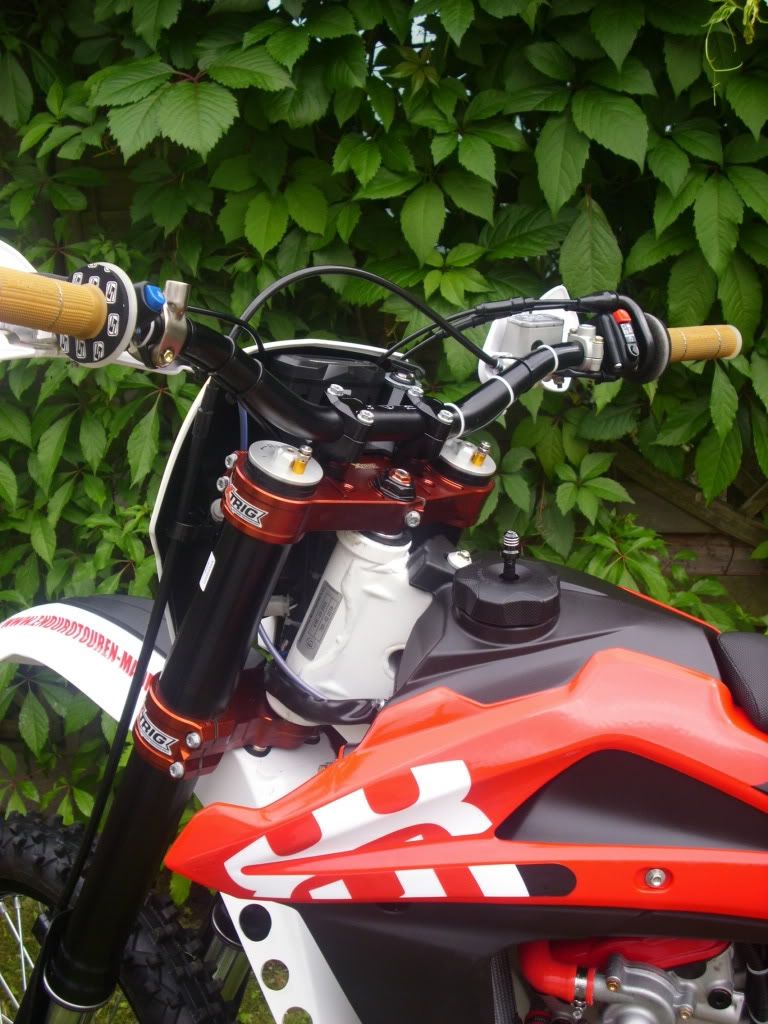Step 1. While the fork is still in the crown make sure to loosen the plug unit on the top of the leg. It is easier to do this know instead of trying to remove the plug unit when the cartridge is removed from the fork in a couple of minutes. You will need a Race Tech pin spanner to remove the cap from the slider and you will also need a 19mm box end to remove the center plug from the cap. Make sure that the top crown is loose before you attempt to release the cap unit from the stanchion
Step 2. Remove the leg from the crowns. At this point you can drain the fork oil from the leg. Make sure to drain the oil into something you can use to measure the amount of oil you remove from the leg. It is a good idea to use fresh oil when you reassemble the fork. Usually around 280cc’s of oil is what will pour out of each leg. After the fork is drained you can hand tighten the cap into the slider and then process to remove the foot nut from the dropout. You will need a 21mm socket to remove the footnut from the dropout.
Step 3. after the footnut has been removed you can slide the cartridge out of the slider. You can leave the spring inside the slider unit just to keep it out of the way! Now you can remove the 19mm plug from the cartridge and dump the oil from the cartridge. Don’t worry about saving the oil because you will need to use fresh oil just to be safe.
Step 4. Make sure to have the cartridge shaft pulled out to full extension. Fill the cartridge halfway and then pump the shaft slowly until you can tell that there is very little air in the oil. Continue this process until the cartridge is full to the top. With the cartridge at full extension insert the plug into the cartridge. Just tighten the plug, you will need to remove it shortly to refill the cartridge.
Step 5. Fully compress the cartridge and let it sit compressed for about 10 seconds. Pull the cartridge to full extension and take a look at the top of the bladder, notice the dimples on the bladder? That is what we need to get rid of to complete the bleed on the system.
Step 6. You will need a special tool to keep the system sealed during this step. I made my tool out of a piece of 1 ½ inch PVC pipe that is about 4mm thick. Cut it in half and get a hose clamp and you are ready to go. Just make sure that the inside edge is smooth so that is will not cut the bladder shave all the corner’s to a dull point.
Step 7. Repeat step 5 so that you can see the dimples again. At this point you can start to slowly compress the cartridge until you start to see the dimples vanish. Keep compressing the cartridge until the bladder is plump (usually about 4’’ into the stroke) to the touch. Now you will have to use the tool you just made to block the ports on the cartridge. Make sure it is all the way against the top cap and then use the hose clamp to fix the two halves of the PVC pipe onto the bladder. Make sure that the fork is still compressed 4’’ the whole time. The idea here is to preload the bladder with a little more oil to get most of the air out of the system for a more consistent feel.
Step 8. Remove the plug from the 19mm plug from the cartridge. Be careful not to touch the bladder, hold it on the actual aluminum portion of the body not the bladder. Now you can extend the cartridge to full stroke. You will notice after you fully extend the cartridge that the oil level will be a bit lower.
Step 9. Top the cartridge off and then reinstall the 19mm plug into the cartridge. You are going to spill some oil at this point so make sure to hang out over some sort of tray to keep the oil off the floor. Just make the 19mm plug hand tight. Go ahead and remove the hose clamp and the halves of the bladder clamp.
Step 10. Repeat step 5. If you see the dimples after you fully extend the cartridge you will have to repeat the last couple of steps until you do not see the dimples when the cartridge is fully extended. You can always make the bladder a little fatter before you clamp the PVC halves onto the bladder.
Step 11. Go ahead and put the cartridge back into the leg. Add about 280cc’s of oil to the leg and you are ready to go.
If you have any questions please feel free to contact Marzocchi Suspension 661-257-6630 or
techron@marzocchiusa.com

 I tried to find this the other day with no luck, after reading reference to it in DB '09 TC450 test.
I tried to find this the other day with no luck, after reading reference to it in DB '09 TC450 test.






 ... I do several rides on my testing ... My clickers are way way out on the compression side also ... and I'm about 148lb without gear ...
... I do several rides on my testing ... My clickers are way way out on the compression side also ... and I'm about 148lb without gear ...